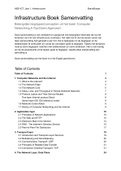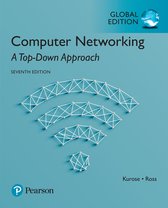HBO-ICT, Jaar 1, Infrastructure BraveBurger
Infrastructure Boek Samenvatting
Belangrijke begrippen/concepten uit het boek ‘Computer
Networking A Top-Down Approach’.
Deze samenvatting is ook verbeterd en aangevuld met belangrijke informatie die op het
tentamen van het vak Infrastructure voorkwam. Het cijfer dat ik met de eerste versie van
deze samenvatting heb gehaald is een 8.9. Het is belangrijk om de begrippen en de
betekenissen te onthouden en vooral de concepten goed te begrijpen. Tijdens het tentamen
moet je soms begrippen matchen met betekenissen en soms andersom. Het is ook handig
om de de powerpoints uit de lessen goed te begrijpen, waarbij deze samenvatting een
aanvulling is.
Deze samenvatting van het boek is in het Engels geschreven.
Table of Contents
Table of Contents 1
1. Computer Networks and the Internet 3
1.1 What is the Internet? 3
1.2 The Network Edge 3
1.3 The Network Core 5
1.4 Delay, Loss, and Throughput in Packet-Switched Networks 7
1.5 Protocol Layers and Their Service Models 8
Five-layer Internet protocol Stack 8
Seven-layer ISO OSI reference model 9
1.6 Networks Under Attack 9
1.7 History of Computer Networking and the Internet 9
2. Application layer 10
2.1 Principles of Network Applications 10
2.2 The Web and HTTP 12
2.3 Electronic Mail in the Internet 14
2.4 DNS - The Internet’s Directory Service 15
2.5 Peer-to-Peer File Distribution 17
3. Transport layer 19
3.1 Introduction and Transport-Layer Services 19
3.2 Multiplexing and Demultiplexing 20
3.3 Connectionless Transport: UDP 20
3.4 Principles of Reliable Data Transfer 21
3.5 Connection-Oriented Transport: TCP 21
4. The Network Layer: Data Plane 24
,HBO-ICT, Jaar 1, Infrastructure BraveBurger
4.1 Overview of Network Layer 24
4.2 What’s inside a Router? 25
4.3 The Internet Protocol (IP): IPv4, Addressing, IPv6, and More 26
5. The Network Layer: Control Plane 29
5.6 ICMP: The Internet Control Message Protocol 29
6. The Link Layer and LANs 29
6.1 Introduction to the Link Layer 29
6.2 Error-Detection and -Correction Techniques 30
8. Security in Computer Networks 31
8.1 What is Network Security? 31
8.2 Principles of Cryptography 31
8.3 Message Integrity and Digital Signatures 32
8.6 Securing TCP Connections 33
8.7 Network-Layer Security: IPsec and Virtual Private Networks 33
8.9 Operational Security: Firewalls and Intrusion Detection Systems 34
Firewall Policy examples 36
,HBO-ICT, Jaar 1, Infrastructure BraveBurger
1. Computer Networks and the Internet
1.1 What is the Internet?
- Devices are called hosts or end systems.
- End systems are connected by a network of communication links and packet
switches.
- Data has a transmission rate and it’s measured on a link in bits/second.
- Examples of packet switches are routers and link-layer switches.
- Sequences of communication links are known as a route or path.
- End systems are connected through internet Service Providers (ISPs).
- Examples of protocols are Transmission Control Protocol (TCP) and Internet
Protocol (IP). The internet’s essential protocols are TCP/IP.
- Internet standards documents are called requests for comments (RFCs) and they
define protocols such as TCP, IP, HTTP and SMTP. There are currently more than
7000 RFCs.
- Distributed applications involve multiple end systems that exchange data.
- End systems attached to the Internet provide a socket interface, which is a set of
rules that the sending program must follow.
- Protocols define the format and the order of messages exchanged between two or
more communicating entities, as well as the actions taken on the transmission and/or
receipt of a message or other event.
1.2 The Network Edge
- Hosts are sometimes further divided into clients and servers, where servers are
often stored in large data centers.
- Digital subscriber line (DSL) and cable are two most prevalent types of broadband
residential access.
- DSL uses telco’s existing local telephone infrastructure.
- DSL and Ethernet use copper wire.
- Cable Internet access makes use of the cable television company’s
infrastructure.
- HFC uses a combination of fiber cable and coaxial cable.
- Mobile access networks use the radio spectrum.
- Fiber to the home provides high speeds (potentially gigabits per second).
- Active optical networks (AONs), essentially switched Ethernet.
- Passive optical networks (PONs), fiber split into multiple fibers for more
homes.
- LANs and Wireless LANs (WLANs) are based on IEEE 802.11 technology (WiFi)
- Telecommunications
- Third generation (3G) - speeds excess 1 Mbps.
- Long-Term Evolution (LTE) - based on 3G, speeds excess 10Mbps.
- Fourth generation (4G)
, HBO-ICT, Jaar 1, Infrastructure BraveBurger
- Each bit traveling from source to destination, it passes through a series of
transmitter-receiver pairs, which is sent by propagating electromagnetic waves or
optical pulses across a physical medium.
- Examples are: twisted-pair, copper wire, coaxial cable, multimode fiber-optic
cable, terrestrial radio spectrum and satellite radio spectrum.
- Physical media fall into two categories: guided media and unguided media.
- Guided media guides waves along solid medium, like fiber-optic cables,
copper or coaxial cable.
- Unguided media propagate waves in the atmosphere, such as wireless LAN
or digital satellite channel.
- Unshielded twisted pair (UTP) is often used for computer networks within a
building, like LANs.
- Data rates for LANs using twisted-pair range from 10Mbps to 10Gbps
(thickness of wire and distance between transmitter and receiver).
- Modern such as cat. 6a cable can achieve 10Gbps up to 100m.
- Coaxial cable contains two copper conductors, but are concentric rather than
parallel, which is often used in cable television systems.
- Coaxial cables can be used as a guided shared medium (multiple end
systems can be connected directly to the cable, with each of the end systems
receiving whatever is sent by the other end systems).
- Fiber optics conduct pulses of light, each representing a bit.
- Can support up to tens or even hundreds of gigabits per second, immune to
electromagnetic interference, up to 100km and are hard to tap.
- Optical Carrier (OC) standard link speeds range from 51.8 Mbps to 39.8
Gbps.
- These specifications are often referred to as OC-n, where the link speed
equals n ∞ 51.8 Mbps. Standards in use today include OC-1, OC-3, OC-12,
OC-24, OC-48, OC-96, OC-192, OC-768.
- Radio channels carry signals in the electromagnetic spectrum, require no physical
wire, can penetrate walls, provide connectivity to mobile users and carry signals for
long distances.
- Communication satellites link two or more Earth-based receivers / ground stations.
- Satellite receives transmissions on one frequency band, regenerates the
signal using a repeater and transmits the signal on another frequency.
- Two types of satellites: Geostationary satellites and low-earth orbiting
(LEO) satellites.
- GEO satellites - permanently on the same spot (36,000km, delay of
280ms), speeds of hundreds of Mbps.
- LEO satellites - rotate around the world (orbit), communicate with
others and ground stations.






